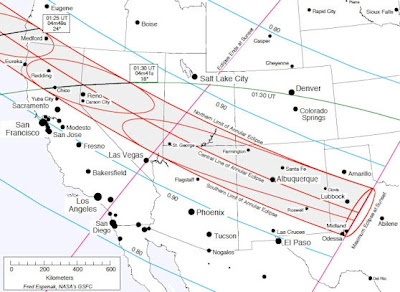I am back from my trip to NASA’s Goddard Space Flight Center, the home of many fantastic missions, including our very own Solar Dynamics Observatory. Every time I visit Goddard, I get to learn about other very interesting science missions. This time I had the pleasure of learning about Landsat. In fact, I got to sit down with Dr. Jim Irons, who is the Landsat Data Continuity Mission Project Scientist and the previous Landsat 7 Deputy Project Scientist.
Have you ever wondered where many of the Earth Images that NASA and the United States Geological Survey (USGS) come from? The images not only provide a wide breadth of data for scientists to study but sometimes are picturesque enough to be art. Take the image of the Richat Structure below in Sahara Desert portion of Mauritania. The picture is not only breathtaking but also provides geologists with insight to the creation of the structure and the various soil types found within the structure. Now instead of telling you, I’m going to ask you, what type of structure do you think the Richat Structure is?

This image is brought to you by Landsat-7, the seventh satellite in the Landsat Program. The Landsat Program is jointly managed by NASA and the United States Geological Survey (USGS), and over the years has consisted of 7, soon to be 8 Earth-observing satellites with the upcoming launch of LDCM (Landsat-8 it will be renamed once it achieves orbit). This first satellite of this program was launched and started collecting data in 1972 making it one of the longer running programs in the history of NASA, up there with the likes of the Voyager program. So for almost 40 years, this program has been taking images of our Earth and helping us understand the changes that go on here on Earth’s surface. Now, how does this tie in with SDO you ask? Well our Sun plays a very important part, since the Landsat instruments measure the solar radiation reflected by the Earth’s surface! For more information on how the images from Landsat are made feel free to visit this
awesome tutorial put forth by the Landsat EPO team.
Now during my recent trip to Goddard, I was able to get in touch with Dr. Jim Irons of the Landsat Program and he was nice enough to sit down and answer questions from some of you. Dr. Irons is a soil scientist (PhD 1993) who is currently the Landsat Data Continuity Mission (LDCM) Project Scientist. Before this he served as the Landsat-7 Deputy Project Scientist. He also is the Associate Deputy Director for Atmospheres in the Earth Sciences Division at Goddard and has been a physical scientist at Goddard for 33 years.

The following are the questions we posed to Dr. Irons that you submitted to us! Again, thank you to Dr. Irons for taking his time and talking to me; I really learned a lot about the Landsat Program. Hope you all enjoy! For more information, follow
@NASA_Landsat on Twitter, look up Landsat on
Facebook, or visit their
website.
Q: What are the differences between an Earth Observing Satellite and a planetary one?
Believe it or not, there are actually many similarities when it comes to Earth and planetary satellites; both are built to make remote observations of a planet. The difference is that Earth observing satellites make observations of the planet we live on. As a consequence, Earth observing satellites are more concerned with sustained observations with which we are very familiar. The changes we see here on Earth often are due to human impacts that can happen very rapidly in comparison to the results of geophysical processes we may see on another planet, which may act over much longer time periods. Planetary Observing Satellites collect more exploratory observations of things that have never been seen before.
Q: What have we been able to learn from Landsat, and more importantly what do you feel is the most significant observation regarding human impact on Earth?
The whole point of the Landsat Program is the scope of human activity. It cannot be narrowed down to one single significant observation but many important examples can be cited: Tropical forest disturbance and recovery is one of them. Before Landsat there were no credible estimates of forest disturbance and recovery within the tropical regions. A program termed Landsat Pathfinder delivered the first rigorous estimates of disturbance rates in the 1990’s and now tropical countries such as Brazil have been able to accurately track and measure that activity on and annual basis using Landsat data .
- A significant and unexpected impact the ability to track water consumption in semi-arid regions such as the western U.S. using Landsat data. The area of irrigated land has increased within the US and globally over the past 40 years of Landsat observations. Water managers have found that they can use Landsat measurements to calculate how much water is being used by irrigated fields for crop production. For more on this, visit this
great article on how Landsat is used to monitor water use from space!
- Landsat also monitors the loss of prime agricultural land due to urban expansion. This isn’t just happening locally. Farms around the world are disappearing as cities grow, and Landsat data is available to monitor that change.
Q: How many miles total has the Landsat program traveled/orbited?

A lot! It hasn’t been calculated, but it definitely can be done. But the answer would be, a lot!
For you math and science people out there, why do you give this a try!
Q: What is LDCM? What’s new about it?

LDCM stands for Landsat Data Continuity Mission; it is the eighth satellite in the Landsat program, again a collaboration between NASA and the USGS. The satellite and its instruments will provide moderate-resolution measurements of Earth’s surface in visible light (the type of light people can see) and other wavelengths of light that people can't see--near-infrared, short wave infrared, and thermal infrared. LDCM will primarily look at land and the poles. A fun fact for you all, the thermal infrared instrument aboard Landsat, also known as TIRS, was built in the same building here at GSFC as Little SDO! This Landsat Satellite has a design life of 5 years but will carry enough fuel for 10 years of operation.

Now one major difference between LDCM and all previous Landsat satellites is that the sensors on LDCM will collect data in a different way. All previous Landsat sensors (with the exception of the rarely used RBV (return beam vidicon) cam) used a moving mirror that moved side-to-side to make measurements across the ground swath, the strip of Earth's surface that Landsat images. For those remote sensing scientists out there, the instruments were multi-spectral electrical optical scanners that employed an oscillating mirror to image across the instrument field of view. On LDCM these sensors (both the operational land imager and the thermal infrared sensor) are push-broom sensors that use a line of detectors that simultaneously make measurements across the swath width. This will offer advancements in radiometric performance and sensitivity.
Q: When is LDCM launching and from where? Can the public watch? What are the mission’s primary objectives?
One of LDCM’s major mission objective is to, as its name states, is to continue the capability to monitor land use and change in land cover across the globe and extend the 40 year-long record of observing the Earth’s surface.
LDCM will be launching out of Vandenberg Air Force Base (VAFB) on an Atlas V rocket. This is because the satellite needs to go into a near polar orbit. Satellites are not launched into polar orbits from Kennedy Space Center/Cape Canaveral launch sites because the launches would require the rockets to begin ascent over populated land areas. The best place for the public to watch launches from Vandenberg, according to their website is off of Corral Road near the VAFB main gate. The launch window for LDCM runs from January 15 to February 15, 2013.
Q: Will we (Landsat Program/US) continue our relationship with SPOT until that time and beyond?
The USGS is capturing some data from the French SPOT remote sensing satellites into its archives although there is no formal connection between the two satellite programs. The data in some respects are similar and depending on the application can be used together; for example, vegetation indices are derived from both Landsat and SPOT data.
However, there is work going on behind the scenes on establishing interactions with the Sentinel-2 program of the European Space Agency (ESA). This program will launch satellites similar to the Landsat satellites beginning in 2013. The current discussion is of cross-calibrations of the Multispectral Imager (MSI) being built for the Sentinel-2 satellites and the Operational Land Imager (OLI) built for the LDCM. More information can be found
here.
Q: What are the various majors and backgrounds of people working on the Landsat Program?
Dr. Irons, himself a soil scientist, put it best when he said, when it comes to the Landsat Program, it’s an open tent!
The scientists that are engaged on the program come from a wide array of earth science fields: geographers, geologists, all varieties of botanists, foresters and forest ecologists, plant physiologists, hydrologists, you name it earth science wise. There are even some social scientists, such as anthropologists and cultural geographers.
On the engineering side, you have the full range of engineers required to design, build, and launch a mission: systems, propulsion, thermal, electrical, mechanical, RF communications, aerospace (There is even a civil engineer on the science side of the program!)
And let’s not forget the others it takes to support a mission such as accountants, managers, consultants, contract specialists, and the list goes on!

















































